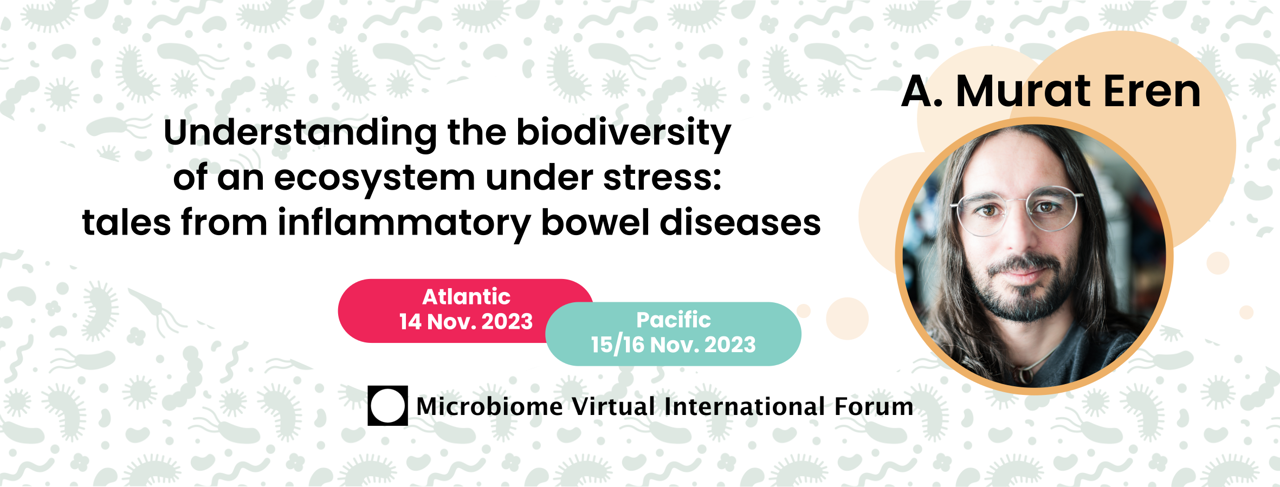Understanding the Biodiversity of an Ecosystem Under Stress: Tales from Inflammatory Bowel Diseases
by Prof. A. Murat Eren
A wide variety of human diseases are associated with loss of microbial diversity in the human gut, inspiring a great interest in the diagnostic or therapeutic potential of the microbiota. However, the ecological forces that drive diversity reduction in disease states remain unclear, rendering it difficult to ascertain the role of the microbiota in disease emergence or severity. One hypothesis to explain this phenomenon is that microbial diversity is diminished simply because disease states select for microbial populations that are more fit to survive environmental stress caused by inflammation or other host factors. The purpose of this talk is to demonstrate how such microbes with 'high metabolic independence', characterized by the genomic presence of a set of key metabolic modules for the synthesis of essential nutrients dominate gut environments under stress. This paradigm depicts microbes as bystanders by default, rather than perpetrators or drivers of noncommunicable human diseases, and provides an ecological framework to explain the frequently observed reduction in microbial diversity associated with IBD and other noncommunicable human diseases and disorders.
Links to two OA papers and an OA perspective for further reading:
- Watson, Fuessel, Veseli et al. (2023): https://genomebiology.biomedcentral.com/articles/10.1186/s13059-023-02924-x
- Veseli et al. (2023): https://elifesciences.org/reviewed-preprints/89862
- Marcelino (2023): https://elifesciences.org/articles/92319
Short Bio
A. Murat Eren (Meren) is a computer scientist, a microbial ecologist, and a professor of the University of Oldenburg and the Helmholtz Institute for Functional Marine Biodiversity. Meren's group uses integrated multi-omics approaches and wet-lab experiments to investigate the ecology and evolution of naturally occurring microbial populations in a wide range of habitats to shed light on strategies by which microbes survive their ever changing environments.
Short Talks
Development of early life gut resistome and mobilome across gestational ages and microbiota-modifying treatments
Background: Gestational age (GA) and associated level of gastrointestinal tract maturation are major factors driving the initial gut microbiota composition in preterm infants. Besides, compared to term infants, premature infants often receive antibiotics to treat infections and probiotics to restore optimal gut microbiota. How GA, antibiotics, and probiotics modulate the microbiota’s core characteristics, gut resistome and mobilome, remains nascent. Methods: We analysed metagenomic data from a longitudinal observational study in six Norwegian neonatal intensive care units to describe the bacterial microbiota of infants of varying GA and receiving different treatments. The cohort consisted of probiotic-supplemented and antibiotic-exposed extremely preterm infants (n = 29), antibiotic-exposed very preterm (n = 25), antibiotic-unexposed very preterm (n = 8), and antibiotic-unexposed full-term (n = 10) infants. The stool samples were collected on days of life 7, 28, 120, and 365, and DNA extraction was followed by shotgun metagenome sequencing and bioinformatical analysis. Findings: The top predictors of microbiota maturation were hospitalisation length and GA. Probiotic administration rendered the gut microbiota and resistome of extremely preterm infants more alike to term infants on day 7 and ameliorated GA-driven loss of microbiota interconnectivity and stability. GA, hospitalisation, and both microbiota-modifying treatments (antibiotics and probiotics) contributed to an elevated carriage of mobile genetic elements in preterm infants compared to term controls. Finally, Escherichia coli was associated with the highest number of antibiotic-resistance genes, followed by Klebsiella pneumoniae and Klebsiella aerogenes. Interpretation: Prolonged hospitalisation, antibiotics, and probiotic intervention contribute to dynamic alterations in resistome and mobilome, gut microbiota characteristics relevant to infection risk.
Link to OA paper: https://www.thelancet.com/journals/ebiom/article/PIIS2352-3964(23)00178-0/fulltext
Ahmed Bargheet
UiT The Arctic University of Norway, Tromsø, Norway
Microbial diversity in aquaculture ecosystems: insights into insect-based feed formulation for sustainable fish farming
Aquaculture, an ancient practice deeply rooted in traditional knowledge, has experienced a recent surge in growth, presenting sustainability challenges. Sustainable aquaculture hinges on several factors, including the well-being of farmed fish, water quality, and feeds. A crucial step toward enhancing sustainability in aquaculture is the transition from fishmeal to alternative protein sources. Extensive research has focused on assessing innovative feed formulations, particularly their impact on the fish gut microbiome. However, limited studies have investigated the microbiome of the aquaculture built environment and host-environment microbiome interactions.
Here, we explored the aquaculture ecosystem microbiome when insect-based novel feed formulations are administered. Using 16S rRNA gene metabarcoding, we conducted a comprehensive analysis of microbiomes across water, tank biofilm, fish intestinal mucus, fish cutis, and feed samples.
Our results showed that overall, water and the aquaculture built environment were characterised by an astounding microbial diversity.
Core microbiome analysis unveiled a highly reduced core shared among all sample sources, in both the control and novel feed test groups.
Network analysis demonstrated sample clustering based on sample source, with no significant variations tied to the feed formulation. Consequently, the different diets did not appear to impact the environment (water and tank biofilm) and fish (cutis and intestinal mucus) microbiomes. For a more detailed examination of the feed's contribution, we conducted a differential abundance analysis, revealing distinct enrichment/depletion of specific taxa when comparing the control to the insect-based diet group.
The results of this study highlight how the aquaculture environment is a unique source of microbes, able to colonise fish. Omic exploration of the water-fish interface exposes patterns that are otherwise undetected: subtle but significant differences in the abundance of specific taxa are exerted by feed. A comprehensive grasp of aquaculture ecosystems as holobiomes is vital to design the built environment and modulate the microbial communities that are hosted for sustainable aquaculture.
Antonia Bruno
University of Milano-Bicocca, Milan, Italy
Microbiome in big pharma: Approach and applications in clinical trials
Petar Scepanovic
Pharmaceutical Research and Early Development (pRED) Microbiome Group, Roche Innovation Center Basel, Switzerland
Highlights
Microbial community-scale metabolic modeling predicts personalized short-chain-fatty-acid production profiles in the human gut
Microbially-derived short-chain fatty acids (SCFAs) in the human gut are tightly coupled to host metabolism, immune regulation, and integrity of the intestinal epithelium. However, the production of SCFAs can vary widely between individuals consuming the same diet, with lower levels often associated with disease. A mechanistic understanding of this heterogeneity is lacking. We present a microbial community-scale metabolic modeling (MCMM) approach to predict individual-specific SCFA production profiles. We assess the quantitative accuracy of our MCMMs using in vitro, ex vivo, and in vivo data. Next, we identify associations between MCMM SCFA predictions and a panel of blood-based clinical chemistries in a large human cohort. Finally, we demonstrate how MCMMs can be leveraged to design personalized dietary, prebiotic, and probiotic interventions that optimize SCFA production in the gut. Our results represent an important advance in engineering gut microbiome functional outputs for precision health and nutrition.
Nick Quinn-Bohmann
Institute for Systems Biology, University of Washington, Seattle, USA
Adaptation of Anaerobic Digestion Microbial Communities to High Ammonium Levels: Insights from Strain-Resolved Metagenomics
In anaerobic digestion (AD), a complex microbial community orchestrates the conversion of organic carbon into CO2 and CH4, with anaerobic archaea playing a pivotal role in methanogenesis. However, AD efficiency can be compromised by various factors, including temperature, pH, O2, salt, and ammonia concentration, with ammonia being a major culprit. Ammonia inhibition often arises when processing N-rich organic wastes, leading to potential disruptions in the digestion process. The toxicity of ammonia in AD is governed by its forms, ammonia and ammonium (NH4+), which are in equilibrium based on temperature and pH. Ammonia toxicity imposes challenges by disrupting intracellular pH and demanding additional energy. Free ammonia nitrogen can penetrate cells, interfering with essential cations and affecting metabolic reactions. Accumulated NH4+ can further destabilize intracellular pH and disrupt cation dynamics. Microbes exposed to toxic ammonia may undergo random mutations that confer a survival advantage. These adaptive mutations enable microbes to enhance their tolerance to ammonia toxicity, modifying proteins involved in stress responses. In this study, a stepwise increase in ammonia concentration up to 20 g NH4+-N/L was explored, a range not previously investigated. Genomic heterogeneity within the AD microbiome and the role of variants have received limited attention in prior research. The study introduced an innovative approach, utilizing strain-resolved metagenomics and single nucleotide variants (SNVs) to monitor microbial dynamics. This approach allowed for a comparative analysis of genetic and ecological fluctuations at both species and strain levels in response to ammonia stress. The study aimed to understand the extent to which microbial communities could adapt to ammonia stress and uncover ammonia-tolerant methanogenic consortia. The results unveiled fine-scale evolutionary mechanisms, functional dynamics, and metabolic variations within the microbial community. Specifically, the archaeon Methanoculleus bourgensis vb3066 and the putative syntrophic acetate-oxidizing bacterium Acetomicrobium sp. ma133 accumulated through generations positively selected SNVs within genes associated with stress adaptation. Additionally, the study highlighted the presence of multiple coexisting strains within species, indicating an additional layer of diversity beyond the species level. In summary, this study delves into the challenges posed by ammonia inhibition in anaerobic digestion processes. By employing advanced techniques in metagenomics and SNV analysis, it provides a comprehensive understanding of how microbial communities adapt to ammonia stress and offers insights into the selection of ammonia-tolerant microorganisms.
Gabriele Ghiotto
University of Padova, Italy

